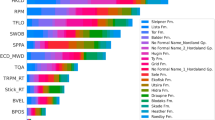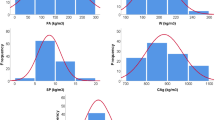Abstract
The durability of aggregates is an important factor that is used as an input parameter in desirable engineering properties along with resistance to exposure conditions. However, it is sometimes difficult to determine the durability of aggregates in the laboratory (with a magnesium sulfate test) because this test is time-consuming and expensive. In this paper, the physical and mechanical properties including water absorption and the Los Angeles coefficient are tailored to the specific evaluation of the durability of limestone aggregates. However, the predictive capabilities of artificial neural networks (ANN) and hybrid particle swarm optimization-based (PSO) ANN techniques have been evaluated and compared using the same input variables. To assess the reliability of the model, some performance indices such as the correlation coefficient (R 2), the variance account for, and the root-mean-square error were calculated and compared for the two developed models. The results revealed that even though the two developed models reliably predict the durability value (magnesium sulfate value), the proposed PSO–ANN method displays an obvious potential for the reliable assessment of the value of magnesium sulfate according to the model performance criterion.




Similar content being viewed by others
References
Al-Harthi AA, Abo-Saada AA (1997) Wadi natural aggregates in western Saudi Arabia for use in concrete. Bull Eng Geol Environ 55(1):125–135
Sharma PK, Singh TN (2008) A correlation between P-wave velocity, impact strength index, slake durability index and uniaxial compressive strength. Bull Eng Geol Environ 67(1):17–22
Mohamad ET, Saad R, Alavi Nezhad Khalil Abad SV (2011) Durability assessment of weak rock by using jar slaking test. Electron J Geotech Eng 16:1319–1335
Fookes PG (1980) An introduction to the influence of natural aggregates on the performance and durability of concrete. Q J Eng Geol Hydrogeol 13(2):207–229
Smith MR, Collis L (2001) Aggregates: sand, gravel and crushed rock aggregates for construction purposes. Geological Society, London. Engineering Geology Special Publication 17
Mehta PK, Monteiro PJM (2006) Concrete: microstructure, properties, and materials, 3rd edn. McGraw-Hill, New York
McNally GH (1998) Soil and rock construction materials. E & FN Spon, London
Thomas MDA, Folliard KJ (2007) Concrete aggregates and the durability of concrete. In: Page CL, Page MM (eds) Durability of concrete and cement composites. Woodhead Publishing Limited and CRC Press, Boca Raton, pp 247–281
ASTM (1998) ASTM C 88 standard test method for soundness of aggregates by use of sodium sulfate or magnesium sulfate. ASTM International, West Conshohocken
EN 1367-2 (2011) Tests for thermal and weathering properties of aggregates—Part 2: magnesium sulfate test. European Standards
EN 1097-6 (2002) Tests for mechanical and physical properties of aggregates—Part 6: determination of particle density and water absorption. European Standards
EN 1097-2 (2010) Tests for mechanical and physical properties of aggregates—Part 2: methods for the determination of resistance to fragmentation. European Standards
Simpson PK (1990) Artificial neural system: foundation, paradigms, applications and implementations. Pergamon, New York
Singh TN, Verma AK, Singh V, Sahu A (2005) Slake durability study of shaly rock and its predictions. Environ Geol 47(2):246–253
Monjezi M, Dehghani H (2008) Evaluation of effect of blasting pattern parameters on back break using neural networks. Int J Rock Mech Min Sci 45:1446–1453
Haykin S (1999) Neural networks, 2nd edn. Prentice-Hall, Englewood Cliffs
Dreyfus G (2005) Neural networks: methodology and application. Springer, Berlin
Sharma PK, Khandelwal M, Singh TN (2011) A correlation between Schmidt hammer rebound numbers with impact strength index, slake durability index and P-wave velocity. Int J Earth Sci 100(1):189–195
Demuth H, Beal M, Hagan M (2007) Neural network toolbox user’s guide. Mathworks, Natick
Sinha S, Singh TN, Singh VK, Verma AK (2010) Epoch determination for neural network by self-organized map (SOM). Comput Geosci 14(1):199–206
Kosko B (1994) Neural networks and fuzzy systems: a dynamical systems approach to machine intelligence. Prentice Hall, New Delhi
Singh R, Kainthola A, Singh TN (2012) Estimation of elastic constant of rocks using an ANFIS approach. Appl Soft Comput 12(1):40–45
Kennedy J, Eberhart RC (1995) Particle swarm optimization. In: Proceedings of the IEEE international conference on neural networks (Perth, Australia). IEEE Service Center, Piscataway, pp 1942–1948
Engelbrecht AP (2007) Computational intelligence: an introduction. John Wiley & Sons, New York, USA
Ferguson D (2004) Particle swarm. University of Victoria, Canada
Eberhart RC, Shi Y (2001) Tracking and optimizing dynamic systems with particle swarms. In: Evolutionary computation. Proceedings of the congress on IEEE, pp 94–100
Van den Bergh F, Engelbrecht AP (2000) Cooperative learning in neural networks using particle swarm optimizers. S Afr Comput J 26:84–90
Jones MT (2005) AI application programming, 2nd edn. Hingham, Massachusetts
Shi Y, Eberhart R (1998) A modified particle swarm optimizer. In: Proceeding of the IEEE international conference of evolutionary computation. IEEE, Piscataway, pp 69–73
Liou SW, Wang CM, Huang YF (2009) Integrative discovery of multifaceted sequence patterns by frame-relayed search and hybrid PSO–ANN. J Univ Comput Sci 5:742–764
Khamesi H, Torabi S, Mirzaei-Nasirabad H, Ghadiri Z (2015) Improving the performance of intelligent back analysis for tunneling using optimized fuzzy systems: case study of the Karaj Subway Line 2 in Iran. J Comput Civ Eng 29(6):05014010
Zorlu K, Gokceoglu C, Ocakoglu F, Nefeslioglu HA, Acikalin S (2008) Prediction of uniaxial compressive strength of sandstones using petrography-based models. Eng Geol 96(3–4):141–158
Yagiz S, Gokceoglu C, Sezer E, Iplikci S (2009) Application of two non-linear prediction tools to the estimation of tunnel boring machine performance. Eng Appl Artif Intell 22(4):808–814
Jahed Armaghani D, Mohamad ET, Hajihassani M, Alavi Nezhad Khalil Abad SV, Marto A, Moghaddam MR (2016) Evaluation and prediction of flyrock resulting from blasting operations using empirical and computational methods. Eng Comput 32(1):109–121
Madhubabu N, Singh PK, Kainthola A, Mahanta B, Tripathy A, Singh TN (2016) Prediction of compressive strength and elastic modulus of carbonate rocks. Measurement 88:202–213
Swingler K (1996) Applying neural networks: a practical guide. Academic Press, New York
Looney CG (1996) Advances in feed-forward neural networks: demystifying knowledge acquiring black boxes. IEEE Trans Knowl Data Eng 8(2):211–226
Nelson M, Illingworth WT (1990) A practical guide to neural nets. Addison-Wesley, Reading
Hush DR (1989) Classification with neural networks: a performance analysis. In: Proceedings of the IEEE international conference on systems engineering, Dayton, OH, USA, pp 277–280
Kanellopoulas I, Wilkinson GG (1997) Strategies and best practice for neural network image classification. Int J Remote Sens 18:711–725
Maulenkamp F, Grima MA (1999) Application of neural networks for the prediction of the unconfined compressive strength (UCS) from Equotip hardness. Int J Rock Mech Min Sci 36:29–39
Ceryan N, Okkan U, Kesimal A (2012) Prediction of unconfined compressive strength of carbonate rocks using artificial neural networks. Environ Earth Sci 68(3):807–819
Ornek M, Laman M, Demir A, Yildiz A (2012) Prediction of bearing capacity of circular footings on soft clay stabilized with granular soil. Soil Found 52(1):69–80
Hecht-Nielsen R (1987) Kolmogorov’s mapping neural network existence theorem. In: Proceedings of the first IEEE international conference on neural networks, San Diego, CA, USA, pp 11–14
Hornik K, Stinchcombe M, White H (1989) Multilayer feedforward networks are universal approximators. Neural Netw 2(5):359–366
Baheer I (2000) Selection of methodology for modeling hysteresis behavior of soils using neural networks. J Comput Aid Civ Infrastruct Eng 5(6):445–463
Tripathy A, Singh TN, Kundu J (2015) Prediction of abrasiveness index of some Indian rocks using soft computing methods. Measurement 68(C):302–309
Sonmez H, Gokceoglu C, Nefeslioglu HA, Kayabasi A (2006) Estimation of rock modulus: for intact rocks with an artificial neural network and for rock masses with a new empirical equation. Int J Rock Mech Min Sci 43:224–235
Sonmez H, Gokceoglu C (2008) Discussion on the paper by H. Gullu and E. Ercelebi, “A neural network approach for attenuation relationships: an application using strong ground motion data from Turkey”. Eng Geol 97:91–93
Hajihassani M, Jahed Armaghani D, Sohaei H, Mohamad ET, Marto A (2014) Prediction of airblast-overpressure induced by blasting using a hybrid artificial neural network and particle swarm optimization. Appl Acoust 80:57–67
Jahed Armaghani D, Raja RSNSB, Faizi K, Rashid ASA (2015) Developing a hybrid PSO–ANN model for estimating the ultimate bearing capacity of rock-socketed piles. Neural Comput Appl. doi:10.1007/s00521-015-2072-z
Gordan B, Jahed Armaghani D, Hajihassani M, Monjezi M (2015) Prediction of seismic slope stability through combination of particle swarm optimization and neural network. Eng Comput. doi:10.1007/s00366-015-0400-7
Mohamad ET, Jahed Armaghani D, Momeni E, Alavi Nezhad Khalil Abad SV (2014) Prediction of the unconfined compressive strength of soft rocks: a PSO-based ANN approach. Bull Eng Geol Environ 74(3):745–757
Clerc M, Kennedy J (2002) The particle swarm explosion, stability, and convergence in a multi-dimensional complex space. IEEE Trans Evolut Comput 6(1):58–73
Ripley BD (1993) Statistical aspects of neural networks. In: Barndoff-Neilsen OE, Jensen JL, Kendall WS (eds) Networks and chaos-statistical and probabilistic aspects. Chapman & Hall, London, pp 40–123
Paola JD (1994) Neural network classification of multispectral imagery. MSc thesis, The University of Arizona, USA
Wang C (1994) A theory of generalization in learning machines with neural application. PhD thesis, The University of Pennsylvania, USA
Masters T (1994) Practical neural network recipes in C++. Academic Press, Boston, MA
Kaastra I, Boyd M (1996) Designing a neural network for forecasting financial and economic time series. Neurocomputing 10:215–236
Acknowledgments
The authors would like to express thanks to the Birjand University of Technology and also Istanbul University for providing research support. The kind cooperation of the quarry for providing aggregate samples is highly appreciated.
Author information
Authors and Affiliations
Corresponding authors
Rights and permissions
About this article
Cite this article
Alavi Nezhad Khalil Abad, S.V., Yilmaz, M., Jahed Armaghani, D. et al. Prediction of the durability of limestone aggregates using computational techniques. Neural Comput & Applic 29, 423–433 (2018). https://doi.org/10.1007/s00521-016-2456-8
Received:
Accepted:
Published:
Issue Date:
DOI: https://doi.org/10.1007/s00521-016-2456-8




